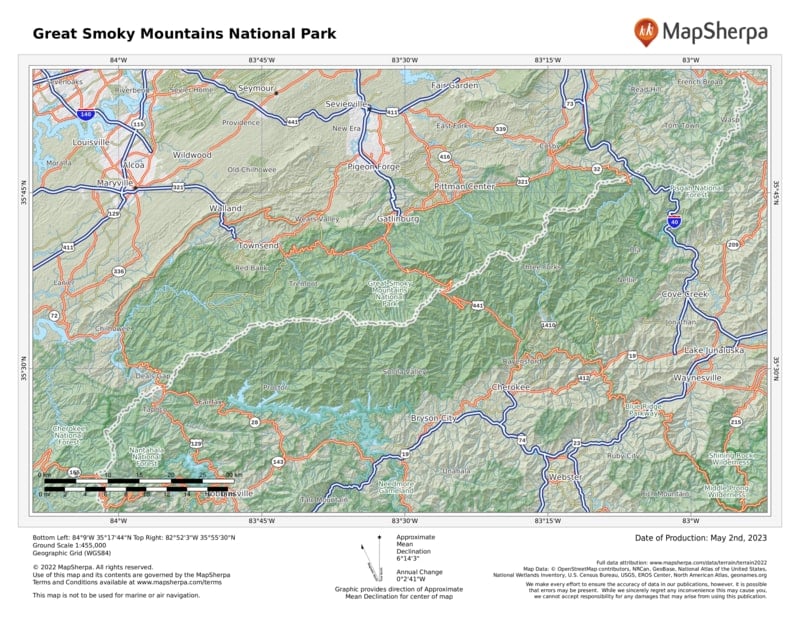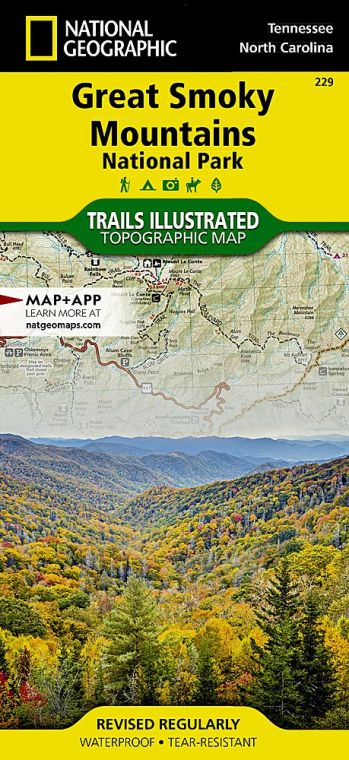Great Smoky Mountains now ranks as America’s most visited national park. It delights millions of annual visitors who come for its ancient mountains, lush forests, diverse flora and fauna, dozens of waterfalls, and engaging history. As part of its overall interpretive mission, the park emphasizes three major themes: biological diversity, the continuum of human presence in the southern Appalachians, and scenic beauty.
The park’s 814 square miles represent the largest federally protected upland area east of the Mississippi River. The elevation range of 875 to 6,643 feet within Great Smoky Mountains creates widely different life zones. Moving from the park’s lowest to highest points is, in effect, like traveling from the Southeast to Maine—from post oaks and wild turkeys to Fraser firs and ravens. Fueled by up to 85 inches of rainfall annually, the park ecosystem boasts a stunning array of plants and animals.
In addition to the ongoing heritage of Cherokee Indians in and near the park, Great Smoky Mountains preserves a nationally significant collection of pioneer-era log buildings as well as structures built during the Depression. Much of the original development of facilities and restoration of early settlers’ buildings was carried out by the Civilian Conservation Corps (CCC), an agency created to provide work and wages for young men during very challenging economic times.
How to Visit
If it is beauty you seek on a one-day visit, a drive up Newfound Gap Road, a hike to Ramsey Cascades, or a trip around Cades Cave Loop Road are certain to reveal varied aspects of the park’s scenic splendor, with vast views over rolling ridges to old-growth forest to the pastoral landscapes shaped by settlers’ farms.
First-timers should experience the park’s most popular destinations. Newfound Gap Road (U.S. 441) bisects the park, climbing over a ridge of the Appalachians, and Cades Cove, a valley, once was home to a thriving farming community.
If you have more time, choosing less-traveled roads and hiking trails—including many easy walkways —allows you to experience the subtle features that are the essence of the park: the massive trunks of century-old tulip trees; the fluting songs of wood thrushes; the tangy scent of a spruce forest.
Indeed, you have to get off the road to really get to know and appreciate the park. There is a wealth of opportunities for intimate discovery.
Forests in the park have suffered in recent years from non-native invasive insects, which have killed firs and hemlocks, altering the natural functions of ecosystems. Park staffers continue to seek solutions, hoping to help control or at least strike a balance with these alien pests.
Dense forests cloak the mighty Appalachians. The moisture they release as a result of evaporation, combined with the area’s high rainfall, often creates fog—the “smoky” mist that gives this mountain range and the park their names.
Useful Information
How to get there
From Knoxville, TN (about 25 miles north), take I-40 to Tenn. 66, then U.S. 441 to the park’s Gatlinburg entrance. From Asheville, NC (about 40 miles east), take I-40 to U.S. 19, then U.S. 441 to the Cherokee entrance. Less traveled routes include the Foothills Parkway (Exit 443 from I-40), U.S. 321 in Tennessee, and the Blue Ridge Parkway in North Carolina.
When to go
The park offers year-round attractions, though the Clingmans Dome Road and some minor unpaved roads are closed in winter. Summer and Oct. weekends are the most crowded times. Winter weather occasionally closes Newfound Gap Road (U.S. 441).
Visitor Centers
Sugarlands, on U.S. 441 south of Gatlinburg, TN; Oconaluftee, on U.S. 441 north of Cherokee, NC.; Cades Cove, on the scenic loop off Laurel Creek Road in the northwestern section of the park. All open year-round.
Headquarters
107 Park Headquarters Road Gatlinburg, TN 37738 nps.gov/grsm 865-436-1200
Camping
Ten developed campgrounds (113 sites); advance reservations are required at Abrams Creek, Balsam Mountain, Big Creek, and Cataloochee (recreation.gov; 877-444-6777). Backcountry camping requires a permit (fee; 865-436-1297).
Lodging
The only lodging within the park is the historic LeConte Lodge (lecontelodge .com; 865-429-5704), reached by a hike of about 5 miles. Seven cabins, three multiroom lodges, no electricity, shared bathrooms. Hotels are plentiful in Gatlinburg, TN (gatlinburg.com; 865-436-4178 or 800-588-1817), as well as Cherokee, NC (cherokeesmokies .com; 828-788-0034), and other nearby communities.
US National Parks Map
About the Guide



